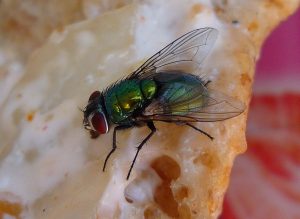For decades, various food safety-types have debated the role of flies in the transmission of disease in food service settings, and more importantly, the significance.
 Now that we live in an old distinguished house in Brisbane, and in every other place we’ve lived close to downtown (CBD) we know screens are an afterthought.
Now that we live in an old distinguished house in Brisbane, and in every other place we’ve lived close to downtown (CBD) we know screens are an afterthought.
And maybe I’m an OK cook, because every time I start slicing and dicing, the flies converge, if the windows are open.
So we got central air installed – Brisbane breezes be damned – and keep the windows closed, yet I still go about my daily slaughter of about 50 flies.
Researchers at Penn State Eberly College of Science have found house flies carry salmonella, E. coli and even bacteria, which can lead to stomach ulcers and fatal sepsis.
The research, published in Scientific Reports, says flies may have been overlooked by public health officials as a source of disease outbreaks.
The paper found that flies legs transferred most of the microbial organisms from one surface to another, suggesting even a brief step onto food could leave behind bacteria.
Flies in urban areas were found to carry more bacteria than rural flies, with the scientists suggesting to avoid city parks for picnics and, instead, eating food in more rural locations.
 The study suggests flies pick up the bacteria from faeces and decaying organic matter, which they use to nurture their young.
The study suggests flies pick up the bacteria from faeces and decaying organic matter, which they use to nurture their young.
”People had some notion that there were pathogens that were carried by flies, but had no idea of the extent to which this is true and the extent to which they are transferred.” said Dr Donald Bryant, Professor of Biotechnology at Penn State University.
“We believe that this may show a mechanism for pathogen transmission that has been overlooked by public health officials.”
